39 - M. G. Haston - His Civic Service and Civil War Experience
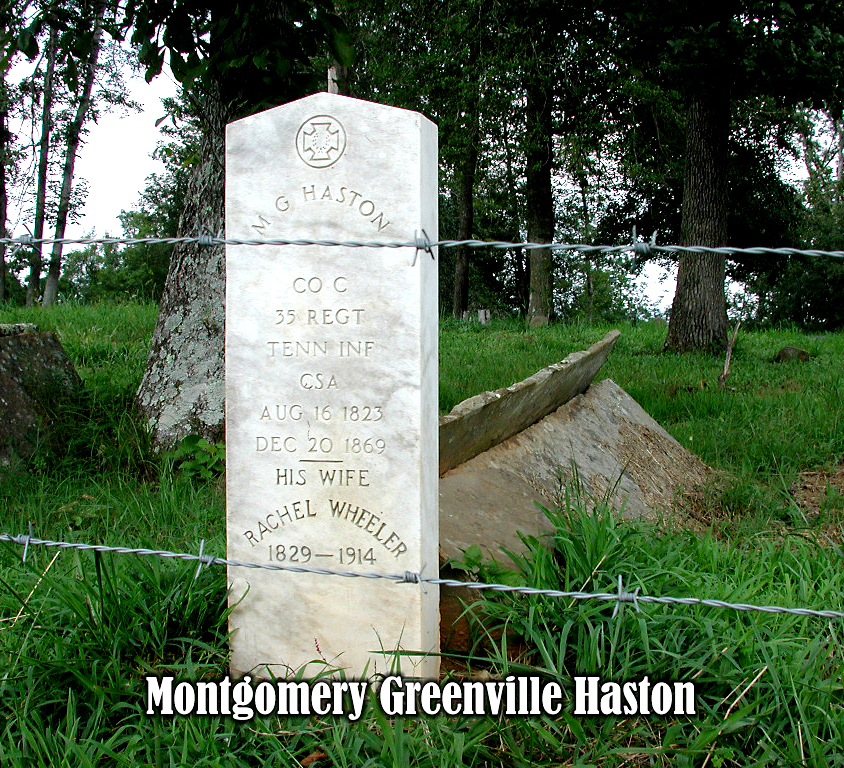
Montgomery Greenville Haston is one of my most respected early Haston heroes! I want to tell you why.
Montgomery Greenville (M.G. or “Gum”) Haston lived a relatively short life even for his era, only about 45 (or 46) years. When he was about 15 ½ years old, Van Buren County, Tennessee was created. For a few years in the mid-1850s, M.G. moved his young family to Georgia to join members of his father-in-law’s family. But most of his adult life was spent in Van Buren County.
Some unofficial documents give his middle name as “Greenfield.” But the oldest daughter of the former Van Buren County, Sheriff Montgomery G. Haston (1898-1936), stated that her father was named after his grandfather, the M.G. Haston who is the subject of this chapter, and the middle name was definitely “Greenville.”[i]
[i] Dorothy Jean Haston Basham, phone conversation with Jean Ann Haston Hall, June 27, 2020.
He certainly made his impact on that young county, early and often rising to positions of leadership. During his life, he served civically in a variety of roles: Constable in the Van Buren County Fourth and Third districts, Van Buren County Fourth District Justice of Peace, Van Buren County Tax Collector, and Captain in the Home Guard for his district.
M.G. Haston's Early Life
For 100+ years, no one seem to know how he fit into the extended Daniel Haston family. But now we know. In the two previous articles you saw that his mother was almost certainly Mary “Polly” Haston, the 2nd oldest child of David and Peggy Roddy Haston. So he was a grandson of David Haston and a great-grandson of Daniel Haston. He was born two or three years prior to the death of Daniel Haston, so Daniel may have held him but M.G. would probably not have had memories of Daniel Haston.
You also saw that he was an illegitimately born child–a “bastard.” Today, that word is a curse word. In M.G.’s lifetime, it was a nasty “b word” that carried a curse with it.
Under English common law, children born out of lawful wedlock were classed as bastards. In the eyes of the law they had no parents, no kindred, and no ancestors. They were not, then, entitled to a surname except such as they won for themselves by reputation, and they were heirs-in-law of no one. The great majority of them were apprenticed at a tender age to a master and condemned to a lowly existence. Bastards ordinarily assumed the surnames of their birth mothers, but they otherwise suffered all of the common-law disabilities. Bastard children were thus disadvantaged from their birth.
George Stevenson, “Bastardy,” NCpedia
A few years after he was born, his mother married William (“Black Bill”) Lewis and he grew up in that Lewis family, at least part of the time. Can you imagine how his peers, including his Lewis step-siblings, used the “bastard” label against him?!
And to make matters even worse for M.G. Haston, his birth-father was very probably his uncle, Arthur Mitchell, Jr. – the husband of his mother’s sister. Certainly, this must have put him in an awkward situation sometimes within the Haston family.
BUT – historical evidence suggests that he was loved among his Haston relatives, especially his Haston grandparents’ family, the David and Peggy Haston family.
Some Highlights of M.G. Haston's Life
The great majority of them (illegitimate children) were apprenticed at a tender age to a master and condemned to a lowly existence.
M.G. Haston was not like the “great majority” of base-born (common term of that era for illegitimately born children). He would not allow himself to be “condemned to a lowly existence!”
August 4, 1845 – Five months after his assignment to a road crew, Montgomery G. Haston shows up in the Van Buren County Court in August 1845 with a certificate showing that he had been elected as constable of the 4th district in Van Buren County. While there, he took the oaths for that office. The Fourth District began just east of the Big Spring Branch and David Haston place and included the entire Cane Creek area.
Think about it—he was age 21 or maybe not quite 21 years old and he was elected to be a constable! He must have been a tough dude with a high degree of community ethos! In those days especially, the job of a constable was a tough one. Constables were largely responsible for law and order in their districts. Montgomery must have been well respected in his district and deemed capable of fighting crime and apprehending and arresting criminals.
October 5, 1846 – Montgomery G. Haston was appointed to be an overseer of a crew to open a road from Denny’s still house to the limekiln on the side of the mountain, a second-class road. William Lewis (his stepfather) and David Lewis (his half brother), as well as Isaac Haston, Carrel [sic] Haston, James W. Haston, John Haston, and several others were on Montgomery’s crew—it was a large road crew, more than 20 men. This was quite an assignment for a 22-year-old man, especially with his stepfather, half-brother, and four Haston relatives on his crew.[i] Surely it tells us something about his leadership abilities. David Haston was one of the justices who made this appointment. I can’t help but wonder if David Haston was behind this assignment in order to prove something to some of these men on the crew, as well as build Montgomery’s confidence and self-esteem.
[i] Van Buren County Court Minutes, April 1840-May 1855, 182.
March 27-28, 1847 – On the 27th of March 1847, M.G. Haston and Rachel Wheeler received their marriage license and were married the next day by David Haston, Justice of the Peace. Rachel Wheeler was born in 1829.[i] Her parents were Burdin (or Burden) and Sally McReynolds Wheeler.
[i] Van Buren County Court Minutes, April 1840-May 1855, page 19 in the marriage records section following page 38 of the 1840 court minutes.
September 24, 1848 – Birth of David Lavender (D.L.) Haston. M.G. and Rachel’s first child was born at this time.
According to the family Bible, Montgomery and Rachel’s first child was named David L. (Lavender) Haston. We don’t know for sure if M.G. and Rachel’s son was named for David Haston. But when you study the pattern of Haston relationships in his life, the evidence is quite strong that Montgomery and Rachel were honoring David Haston, the father of Mary/Polly Haston, by giving their first son the name David.

If Polly’s illegitimately-born son lived with David and Peggy Haston for the first three years of his life, David would have been Montgomery’s surrogate father in those formative years. And since the boy didn’t have a birth-father who could and would take care of him, David would probably have taken a special interest him, perhaps more so than his other grandsons. And the bonding that would have happened in those first three years would have been tight and permanent, assuming the relationship was as loving as evidence seems to indicate it was in the David Haston family. So it seems only natural that Montgomery and Rachel’s first son would have been named David.
January 2, 1854 – M.G. Haston and David Lewis (probably the half-brother of M.G. Haston), had recently been involved in a brawl: State vs. David Lewis and M.G. Haston (affray). M.G. and David were charged $4.00 (apparently $2.00 each) for the court costs.[i]
[i] Van Buren County Court Minutes, April 1840-May 1855, 442.
After January 1854 to or before November 3, 1858 – M.G. Haston and his family moved to Walker County, GA for a few years. The answer to why he went to Walker County, Georgia is connected to his wife’s family, the Wheelers. Rachel’s father was Birden Wheeler, a brother of John Riley Wheeler who had a mercantile business in the Sequatchie Valley.
John Riley Wheeler, Rachel’s uncle, moved his mercantile business from Bledsoe (soon to become Sequatchie) County, Tennessee to the Cedar Grove community of Walker County, Georgia (south of Chattanooga, TN) at, or about, the same time M.G. moved his family there from Van Buren County. They very possibly traveled together. Maybe M.G. was seeking to make a quick small-fortune as a merchant with Rachel’s Uncle Riley. And as a consolation, there his illegitimate birth would have been unknown—sheltering him from conflicts with his Lewis half-brothers and others.
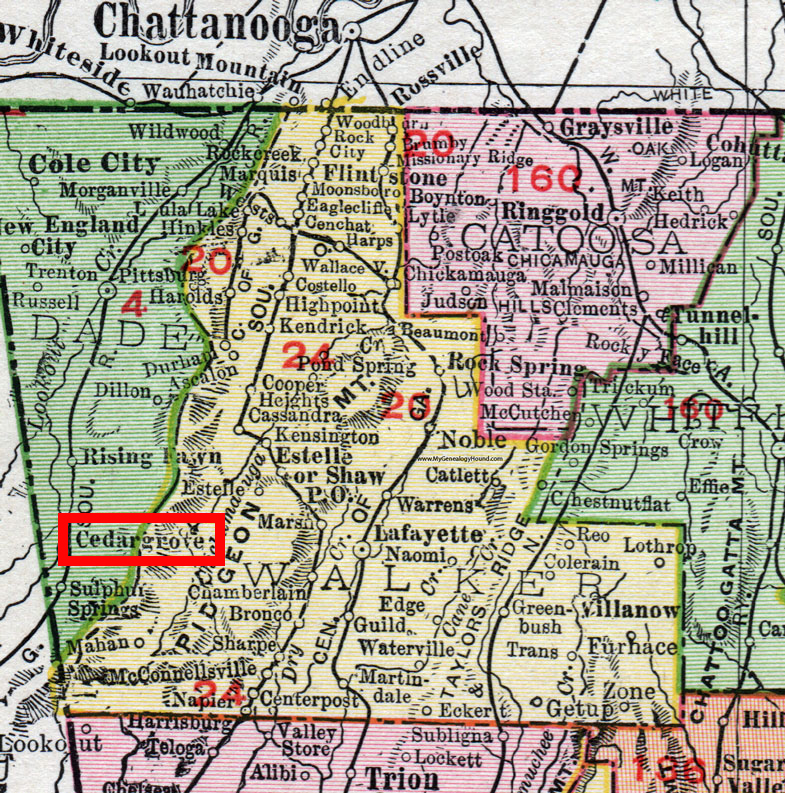
October 1, 1860 – M.G. Haston, along with John M. Billingsly and D.P. Myers, was a judge in the 4th district for the 1860 presidential election. This was the election in which Abraham Lincoln was elected, the election that ultimately precipitated the Civil War.[i]
[i] Van Buren County, Tennessee County Court Minutes, June 1855-December 1860, 422.
December 3, 1860 – M.G. Haston and William C. Haston were appointed to lay off and set apart to Nancy Jane Myers, widow of Dillard P. Myers deceased, one year support and report the same to the next term of court.[i]
[i] Van Buren County, Tennessee County Court Minutes, June 1855-December 1860, 432.
NOTE: D.P. Myers was a younger brother of Lansden E. Myers, who was the father of “Josie Myers” that will play an important role in the next article in this series.
June 3 & 4, 1861 – M.G. Haston, one of the Justices of the Peace in this session, was appointed on Tuesday, June 4, as Captain of the Home Guard in the Fourth District of Van Buren County. J.J. Walker was the 1st Lieutenant and W. Wheeler the 2nd Lieutenant.[i]
[i] Van Buren County, Tennessee County Court Minutes, January 1861-June 1866, 60, 66.
July 1, 1861 – M.G. Haston was appointed to be the man in the Fourth District to look after the “wives and children of the volunteers now in the service of our country” and report their needs to the chairman of the county court.[i]
[i] Van Buren County, Tennessee County Court Minutes, January 1861-June 1866, 67, 72, 74.
July 2, 1861 – Tennessee Admitted to the Confederacy

April 7, 1862 – William C. Haston, David’s youngest son (and M.G. Haston’s “younger uncle”), was elected as Sheriff, as of March 1, 1862. In this April 7 session, Isaac T. Hastin, Mongumry [sic] G. Hastin, and John J. Walker entered into a couple of bonds as his securities. One bond was priced at $12,000 and there was another for $500.[i] W.C. Haston had previously served as constable in the Third District and Deputy Sheriff for the county.[ii] Being the County Sheriff during the Civil War must have been a hugely challenging job!
[i] Van Buren County, Tennessee County Court Minutes, January 1861-June 1866, 108-109.
[ii] Van Buren County, Tennessee County Court Minutes, January 1861-June 1866, 65.
Apparently in preparation for the impending first Confederate Conscription Act, “This day the Chairman in open court appointed…men, one in each civil district of Van Buren County, to take down in these districts respectively all the able bodied men thence subject to military duty over the age of eighteen and under fifty five years old and report the same immediately to Adjutant General of the State of Tennessee.” W.C. Haston was the appointed man in the Third District and M.G. Haston was appointed for the task in the Fourth District.” Both of these men were well within the age-range specified for the lists.[i]
[i] Van Buren County, Tennessee County Court Minutes, January 1861-June 1866, 110.
Montgomery G. Haston was voted in to fill the office of Revenue Collection (Tax Collector) for two years.
November 3 & 4, 1862 – M.G. Haston was one of the Justices in this term of court. He was appointed to “enroll the Confederates of Van Buren County” in his Fourth District, as were all of the other Justices of the Peace for their districts, including William C. Haston for the Third District.[i]
[i] Van Buren County, Tennessee County Court Minutes, January 1861-June 1866, 132.
April 6, 1863 – M.G. Haston, Esqr. resigned his office as Justice of the Peace for the Fourth District of Van Buren County. He also resigned from his office of Tax Collector for Van Buren County at the same time. Perhaps it was becoming clear to him that the county government was facing a shutdown. But he did submit a report of lands and lots and their owners, as well as the amount of taxes they had not paid.[i]
[i] Van Buren County, Tennessee County Court Minutes, January 1861-June 1866, 156, 161.
M.G. Haston's Confederate Military Experiences
At the time M.G. Haston resigned his public offices in Van Buren County, he was approaching 40 years of age. He owned more than 1000 acres, was married with a wife and several young kids to feed and care for, and had been fulfilling some key roles in trying to hold the county together during a very difficult time. But Middle Tennessee was on the brink of being overcome by Federal soldiers.
In the spring of 1863, M.G. Haston and other citizens of surrounding counties knew they were facing the possibility of a Federal Army occupation. And they knew what occupation by enemy troops would mean. Pro-southern guerilla fighters–some of whom were nothing more than thieves, robbers, and murderers–were dangerous enough. But a massive occupation by Federal troops would be devastating to farms and their families.
The only thing preventing that occupation was the Army of Tennessee under the leadership of General Braxton Bragg. But Bragg’s army had fought to a draw in Murfreesboro’s Battle of Stone’s River and retreated to take a stand at Tullahoma. Bragg, and all of western Middle Tennessee, were facing the realities of (1) a win at Tullahoma and a forced retreat of the Union Army, or (2) a surrender of south-central Tennessee to a swarming army of enemy soldiers.
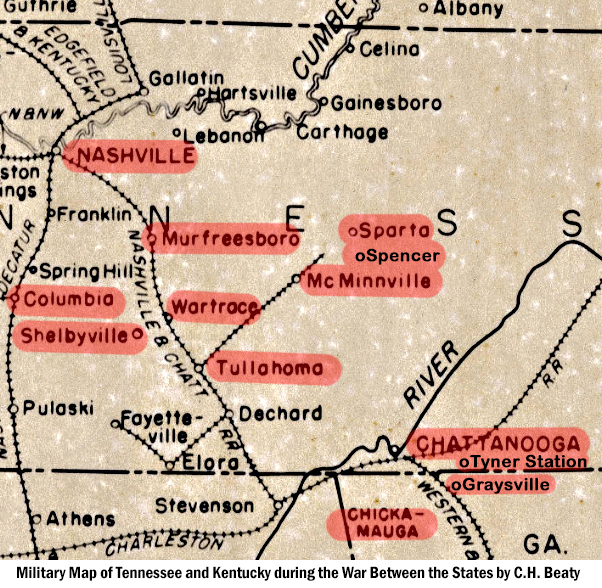
M.G. Haston joined Company C of the 35th Regiment Tennessee Infantry as a private on June 16, 1863.[i] He enrolled in McMinnville for a term of service of three years or the entire war, with Colonel Nixon as his enrolling officer.
[i] “M.G. Haston,” Fold3.com, accessed June 6, 2020, https://www.fold3.com/image/76762118?terms=haston,40.
Tullahoma (TN) Campaign - June 24 - July 3, 1863
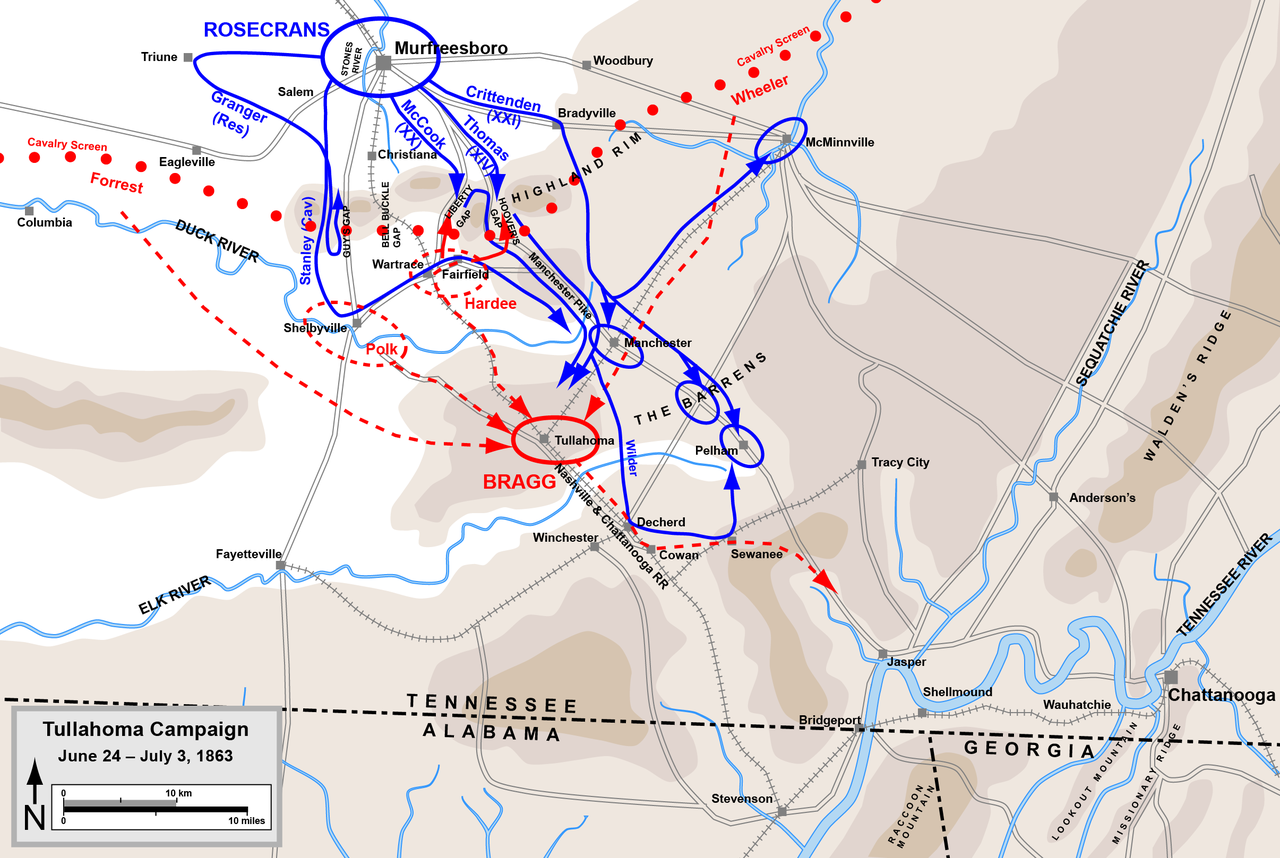
After a few days of positioning and fighting in miserable rain, General Bragg chose to retreat to Chattanooga. Much to the disappointment of many of his troops, especially those recruited from southcentral Tennessee, Bragg left businesses, farms, and families (especially pro-Southern families) wholly unprotected.
Immediately, many of the Confederate volunteers from that local area began to desert, to go home to protect their wives, children, and property. The defensive mode became personal to many of them, the dike had burst and the flood of enemy raiders was at hand.
M.G. Haston remained with Bragg and the Army of Tennessee in the retreat to “Tanner’s Station” (Tyner), east of Chattanooga. He reported for the July 17, 1863 muster there. But deserted on July 31.
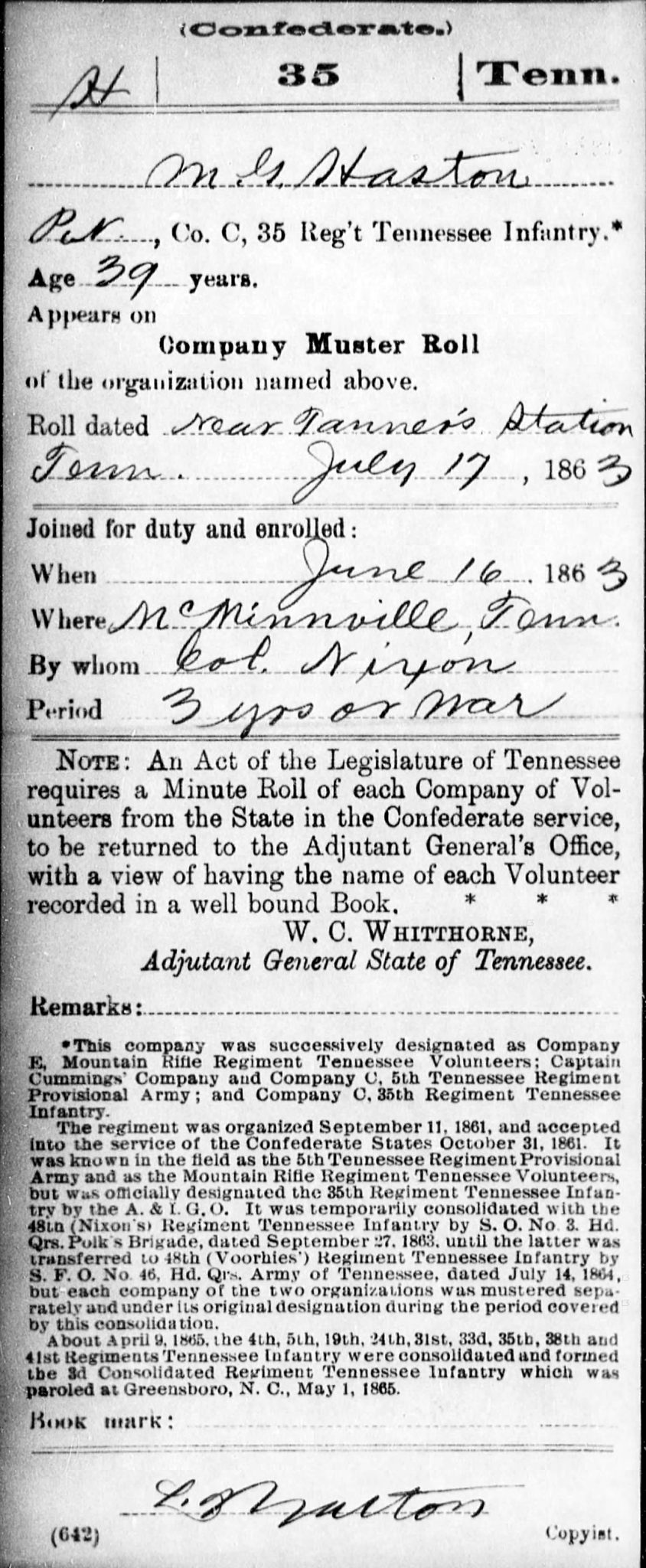
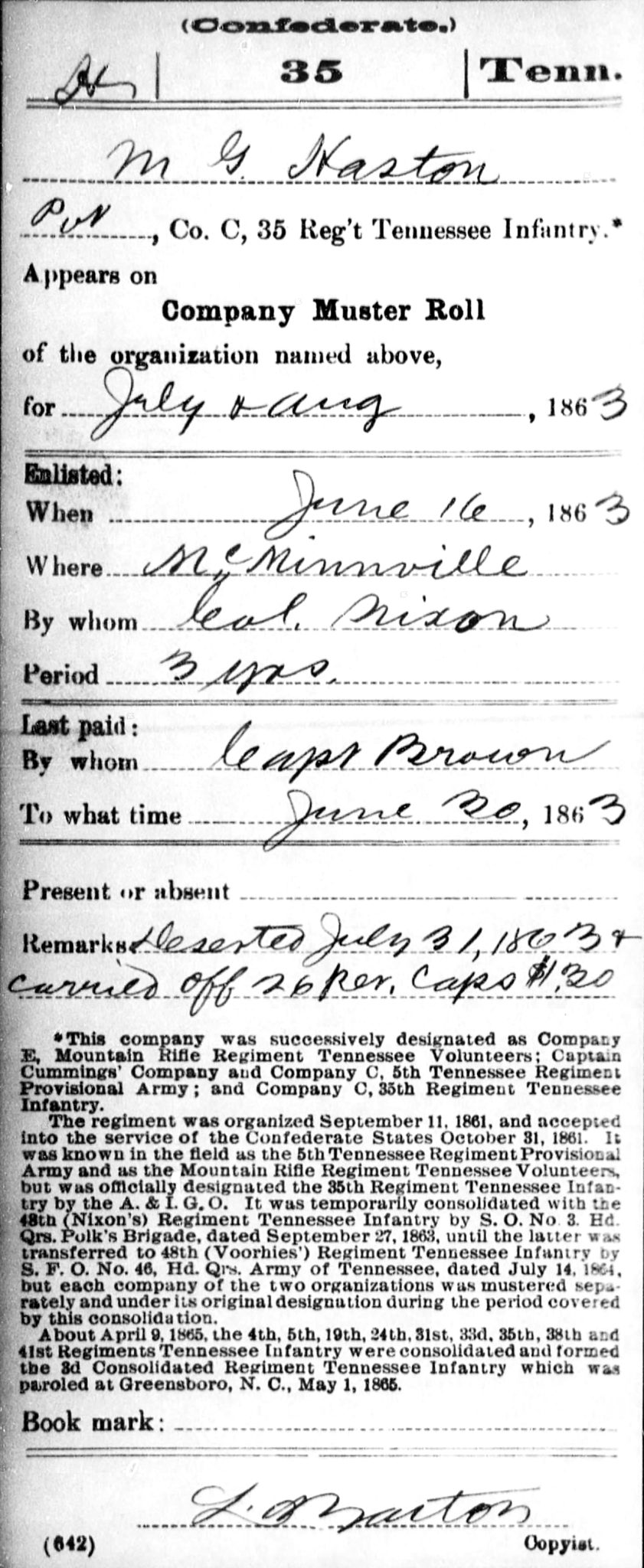
Some Thoughts About M.G. Haston's Civil War Experience
For a starter, let me say: I do not think M.G. Haston deserted because he was a coward.
The most thorough and best documented book on this topic is More Damning than Slaughter: Desertion in the Confederate Army by Mark A. Weitz.[i] Weitz states: “Studies to date suggest that deserters were not cowards, or at least most of them were not. When it struck, desertion took quality soldiers and undermined good units.”[ii]
[i] Mark A. Weitz, More Damning than Slaughter: Desertion in the Confederate Army. (Lincoln, NE: The University of Nebraska Press, 2005).
[ii] Weitz, xvii.
- If you have closely followed the earlier adult life of M.G. Haston, you will likely agree that he was an intelligent, bold, strong, courageous man who did not back down from personal confrontations or common challenges of life.
In 20 years, he climbed more rungs of the civic leadership ladder in Van Buren County than most of his contemporaries ascended in 50 years. No doubt, he turned the “lemons” of his life into “lemonade”—his uphill struggles as a “baseborn” child made him wiser and stronger than he would have been otherwise.
That is why the word “deserted” on his Confederate army record seems so wrong, so uncharacteristic for him. I am not a descendant of M.G. Haston, although we are genealogically connected through David Haston. So as I share my thoughts here, I am not trying to sugar-coat his desertion. But knowing what I know about the events of the war occurring in Middle Tennessee when he enlisted and the longer-term results of those events, I think I may understand what led to his desertion.
- With the eastern end of the Confederate defensive line within 30 miles of his home, it is likely he volunteered to help turn back the tide of a Yankee invasion, to protect his family and his farm.
When M.G. Haston enlisted on June 16, 1863, he left many acres of farmland behind—a farm and home broadly exposed at the crossroads of two main roads. He left a wife and six kids at home—David L. (age 15), William Riley (age 12), Mary Jane (age 8), James Birden (age 6), Thomas M. (age 2), Joel M. (age 4 months).
M.G. Haston, like the other Hastons in Tennessee, was not a slave owner. He was not fighting to protect the institution of slavery. He was fighting to protect those things and the people he loved, especially his wife and his children. And when it became necessary to be at home to protect them, that’s what he chose to do.
Death of Montgomery Greenville Haston
December 20, 1869 – Montgomery G. Haston died on this date, a young man of about age 45. The end of Montgomery G. Haston’s life is just as mysterious as its beginning, for those of us more than 150 years removed from his.
July 25, 1914 – Rachel Wheeler Haston died of heart failure and was buried the following day, July 26. The grave adjacent to and north of M.G. Haston’s grave is probably hers.
If you appreciated this article, please share it with others who might also enjoy it.

